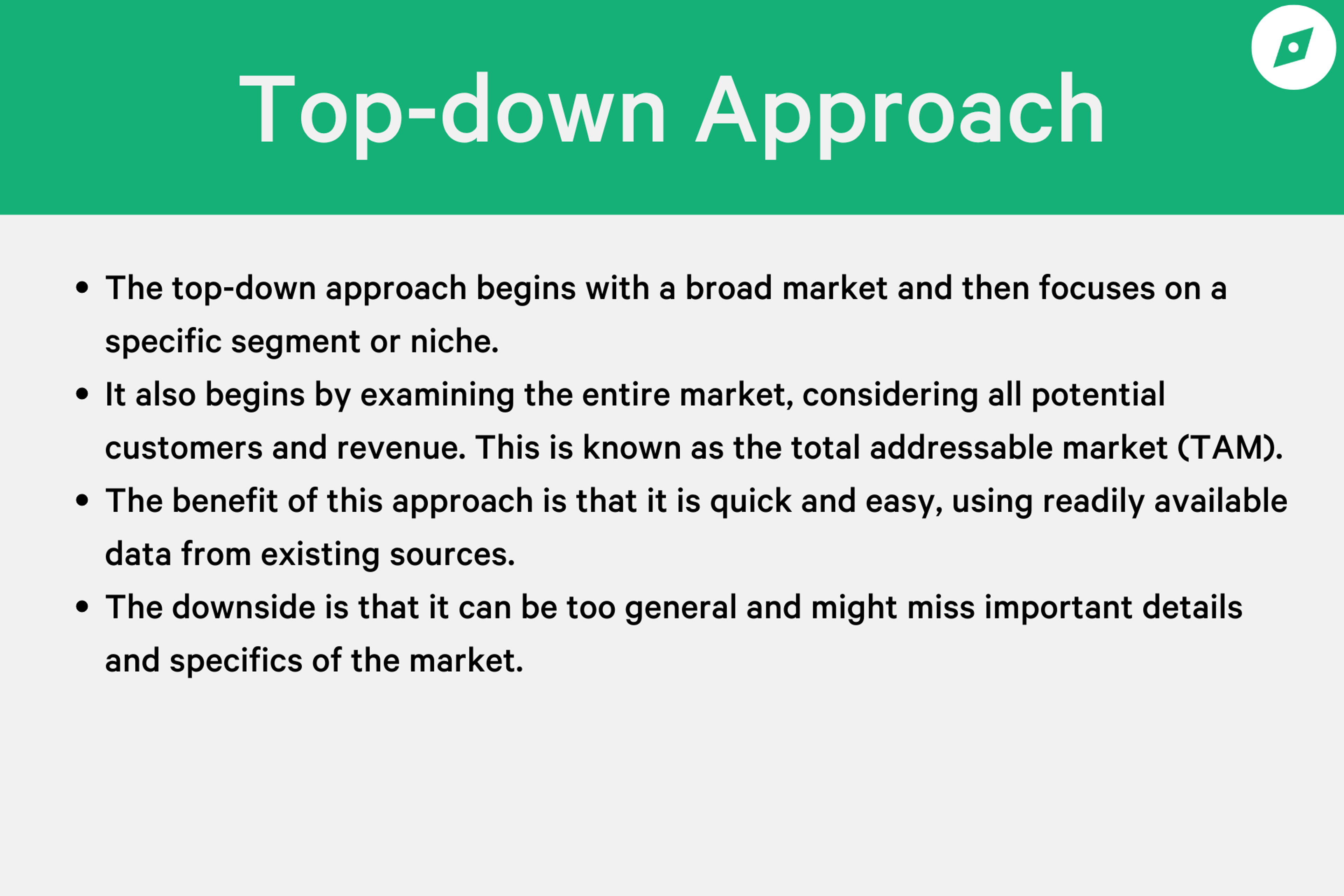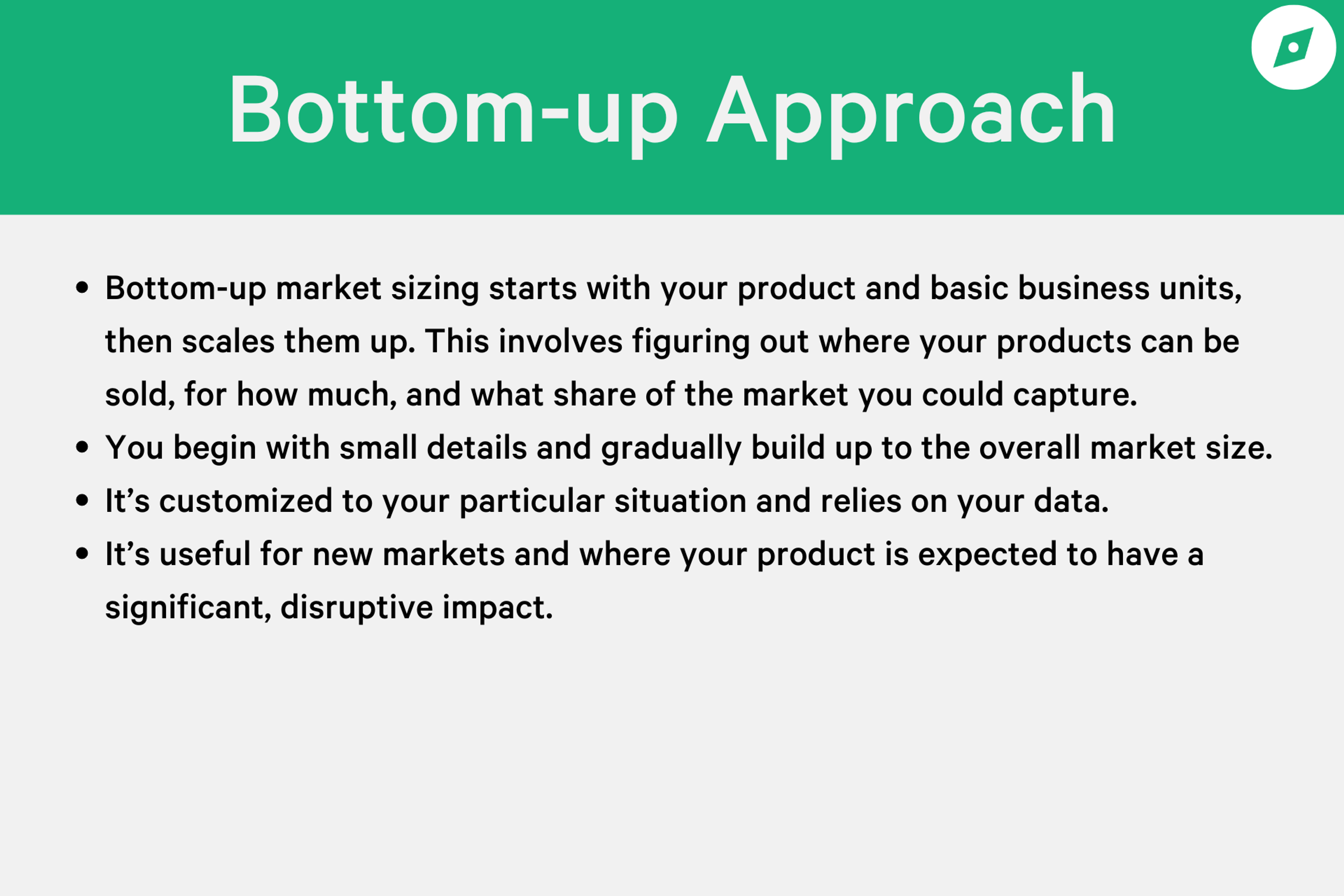The Expert Guide to Market Sizing Questions (With Examples)
Looking for an expert guide to market sizing questions? Learn how you can use the examples, key techniques, and frameworks to ace your consulting interviews by reading this article.
Posted June 30, 2025

Join a free event
Learn from top coaches and industry experts in live, interactive sessions you can join for free.
Table of Contents
Navigating market sizing questions can feel like solving a complex puzzle, offering key business insights. Whether preparing for a consulting case interview or planning a market venture, understanding market sizing is crucial. These questions test your analytical skills, creativity, and logical reasoning. This guide simplifies the subject, helping you master market sizing skills, essential for consulting interviews and business decisions.
We'll explore what market sizing questions are and why they're crucial in consulting interviews and business planning. You'll learn the key steps to approach these questions, including clarifying questions, the top-down and bottom-up approaches, and common formulas to simplify calculations. We'll provide a sample market sizing question, examples, and a comprehensive framework to tackle any market sizing case confidently. By the end of this article, you'll be prepared to handle market sizing questions in any context, enhancing your skills for consulting interviews and beyond. So, let’s dive in!
What Are Market Sizing Questions?
A market sizing question requires you to estimate the size of a certain case with minimal or no data available. This could involve calculating the annual revenue of a market, analyzing age groups, or determining the number of units sold within that market.
Market sizing questions are a fundamental component of consulting case interviews, where consulting firms task you with estimating the potential market size under conditions of limited data. These questions test your ability to perform quick, rough calculations and make educated guesses about market values or volumes. Mastering these skills is crucial for successfully tackling any market sizing case you may encounter.
Examples of Market Sizing Questions
You might encounter a variety of market sizing questions during interviews at top consulting firms like McKinsey, Deloitte, or even tech giants like Google.
- How many gas stations are there in downtown Dallas?
- Estimate the total population of Manila
- How many cars are currently being sold in the UK?
- What are the annual sales of the European shoe market based in Los Angeles?
- How many hot dogs are being sold daily in New York?
These questions require you to apply logical reasoning and basic mathematical skills to provide estimates that could range from the total number of iPhones currently used in China to the monthly profit of coffee cups being sold in Seattle.
Consulting firms use these questions to assess a candidate's quantitative skills, logical reasoning, and practical business acumen. The ability to quickly provide ballpark figures during client meetings can be crucial, making these skills highly valuable in consulting and strategic business roles.
Know What Your Interviewer Expects From You
This is your chance to show your analytical skills by demonstrating your ability to break down complex problems into manageable parts and perform quick, accurate calculations.
Understand the Question Clearly
- Ask Clarifying Questions: Ensure you fully understand the scope and context of the market sizing question. Clarify any ambiguous terms or assumptions.
- Restate the Problem: Summarize the question in your own words to confirm your understanding.
Demonstrate a Logical Approach
- Outline Your Framework: Clearly articulate the method or framework you plan to use. Whether it’s a top-down, bottom-up, or another approach, make your strategy known.
- Step-by-Step Breakdown: Explain your reasoning step-by-step to show a structured thought process.
Make Reasonable Assumptions
- State Assumptions Explicitly: Clearly state any assumptions you make. These could relate to population size, consumption rates, market penetration, etc.
- Justify Assumptions: Provide rationale for your assumptions. Use logical reasoning or relevant data to back them up.
Showcase Analytical Skills
- Quantitative Estimation: Use numbers and calculations to provide a quantitative estimate. Show your ability to handle data and perform basic arithmetic.
- Analytical Thinking: Demonstrate how you break down complex problems into manageable parts.
Communicate Clearly
- Speak Clearly and Concisely: Communicate your thought process and calculations clearly. Avoid jargon and keep your explanations simple.
- Engage with the Interviewer: Maintain eye contact, be attentive to feedback, and be open to suggestions or corrections.
Demonstrate Business Acumen
- Relate to Real-World Context: Show how your market sizing relates to real-world business scenarios. Demonstrate your understanding of market dynamics and industry specifics.
- Insightful Conclusions: Draw insightful conclusions from your market sizing. Discuss potential business implications or strategies based on your findings.
Handle Uncertainty Gracefully
- Acknowledge Uncertainties: Recognize areas where your estimates might have a margin of error. Show that you understand the limitations of your approach.
- Offer Ranges: Provide a range for your estimates if exact numbers are uncertain. This shows you’re aware of potential variability.
Practice Problem-Solving Under Pressure
- Stay Calm and Composed: Maintain composure even if the question is challenging. Your ability to think clearly under pressure is being assessed.
- Practice Mock Interviews: Engage in practice interviews with friends or mentors to build confidence and improve your problem-solving skills.
By focusing on these aspects, you can align your responses with what interviewers typically look for in market sizing questions. This includes clarity of thought, structured approach, logical reasoning, and effective communication, all of which are critical in demonstrating your capability as a potential consultant.
Key Steps to Approach Market Sizing Questions
How to Answer Market Sizing Questions
When faced with a market sizing question, it's essential to first make sure you understand exactly what is being asked. To answer market sizing questions effectively, begin by asking clarifying questions to grasp the exact requirements of what you're being asked to estimate. This might involve understanding the definition of the market size, whether it refers to volume or value, and the specific timeframe or geographical scope you should consider. Regularly engaging in market sizing drills and practicing market sizing questions can help you develop the skills needed to tackle these queries with confidence.
Clarifying Questions to Ask
How important is asking clarifying questions? Well, it’s more like a sense check. One of the reasons is to give the interviewer your thought process in management consulting. Clarifying questions are crucial to narrow down the scope and specifics of the market sizing task. You should inquire about the types of products to include or exclude, the relevant customer segments, and the distribution channels that are applicable to the market sizing question. For instance, if tasked with estimating the size of the lipstick market, you need to clarify whether all types of lipsticks or only specific varieties, such as gloss or matte, are to be considered.
Structuring Your Approach
Once you have a clear understanding of the task, develop a structured approach or framework for your calculations. This involves deciding between a top-down or bottom-up approach based on the market's characteristics. For broader, diverse markets, a top-down approach might be more suitable, whereas for more localized or homogeneous markets, the bottom-up approach could be more effective.
- Develop a Framework: Start by creating a framework that outlines the steps you'll follow. This helps in organizing your thoughts and ensures that you cover all necessary aspects of the problem.
- Make Assumptions and Calculations: Use round numbers for your estimates to simplify calculations. This step involves making educated guesses about necessary figures to compute the market size. Remember, the accuracy of your final estimate depends significantly on the reasonableness of your assumptions.
- Sense Check Your Answer: After arriving at an answer, perform a sense check to evaluate its plausibility. This doesn't just help in catching potential errors but also reassures that your approach and assumptions were reasonable.
- Determine Implications: Consider the broader implications of your estimate. Discuss how the findings could influence business strategy or decision-making processes. This step demonstrates your ability to think beyond numbers and adds depth to your analysis.
By following these structured steps, you can effectively tackle market sizing questions with confidence, demonstrating both your analytical skills and business acumen.
Demonstrate Common Formulas and Methods
Now that you know the key steps to take to approach the market sizing questions, let’s take you what the common approaches are. When it comes to market sizing question interviews, there will be times that the interviewer will ask you about a target market, pricing and revenue models, or even stumble upon market sizing cases, but for this matter, it’s important to understand these two most common methods in the market sizing approach:
Top-down Approach
The top-down market sizing methodology begins by examining the overall market size and then narrowing it down to a segment that is relevant to your interests. This approach starts with a broad view, utilizing existing market data from reliable sources such as industry reports or analyst estimates, to determine the total addressable market (TAM). Once the TAM is established, you can then apply filters to derive the serviceable available market (SAM) and eventually the serviceable obtainable market (SOM), which are more specific to your target audience.
A key advantage of the top-down approach is its speed and efficiency, especially when comprehensive market data is readily available. It allows for a quick estimation, which can be particularly useful in well-established markets with abundant data. However, this method may provide an overly optimistic view of the market size and might not be as effective in new or disruptive market segments where less historical data is available.

Bottom-up Approach
On the flip side, the bottom-up approach works from the ground up. It starts with details like how many customers there are or how many units might be sold, and then adds everything up to estimate the market size. This method involves calculating things from the base level, like the number of units and their average price, to figure out the total market size.
For instance, if assessing the market for coffins, you would start by estimating the number of deaths leading to burials, then determine how many of those would require coffins, and multiply by the average cost of a coffin to get your market size estimate. This approach is highly tailored to your specific circumstances and can provide a more accurate forecast, especially in new markets or where your product could significantly impact the market dynamics.
The bottom-up method is advantageous for its accuracy and the detailed insight it provides into customer segments and pricing strategies. However, it is more time-consuming and resource-intensive, requiring precise data collection and validation to avoid errors that could skew the entire analysis.
By understanding both the top-down and bottom-up approaches, you can choose the most appropriate method based on the characteristics of the market you are analyzing, ensuring that your market sizing efforts are both efficient and effective.

Should You Use a Market Sizing Cheat Sheet?
Using a market sizing cheat sheet can be helpful in market sizing interviews as it provides a quick reference for common data points and methodologies. However, it’s important to understand the underlying principles and not rely solely on the cheat sheet. Demonstrating your ability to think critically and apply logical reasoning is crucial for success in these interviews.
A market sizing cheat sheet typically includes common data points, conversion factors, and frameworks that can help you quickly estimate market sizes during interviews. Here are some examples:
Population Data
- Global Population: 8 billion
- US Population: 340 million
- EU Population: 450 million
Income Data
- Median US Household Income: $68,700
- Percentage of High-Income Households (>$100k): 30%
Demographic Data
- Percentage of Population by Age Group (US):
- 0-14 years: 19%
- 15-64 years: 65%
- 65+ years: 16%
Market Penetration Rates
- Smartphone Penetration (US): 85%
- Internet Penetration (Global): 60%
Industry-Specific Data
- Average Car Lifespan: 12 years
- Average Smartphone Replacement Cycle: 2-3 years
- Average Grocery Spend per Household (US): $5,000/year
Frameworks and Formulas
1. Top-Down Approach:
Start with a large population and segment it down.
Example: Total population → % target demographic → % likely to use the product → Average spend per user.
2. Bottom-Up Approach:
Start with small units and scale up.
Example: Number of stores → Average sales per store → Total market size.
3. Volume x Price:
Estimate the number of units sold and multiply by the average price per unit.
Example: Number of units sold annually x Average price per unit.
Tips for Using Cheat Sheets
- Understand the Data: Familiarize yourself with common data points and conversion factors.
- Practice Frameworks: Apply frameworks to different types of market sizing questions.
- Stay Flexible: Be prepared to adapt your approach based on the specifics of the question.
Using a market sizing cheat sheet as a reference can help streamline your thought process and ensure you don't overlook key factors during the interview.
Practice Examples with Answers You Can Try
Practice Example 1: Estimating the Annual Market Size for Coffee Shops in New York City
Question:
Estimate the annual revenue generated by all coffee shops in New York City.
Answer:
1. Population of NYC:
- Approx. 8.5 million people.
2. Coffee Drinkers:
- Assume 70% of the population drinks coffee regularly.
- 8.5 million * 70% = 5.95 million coffee drinkers.
3. Daily Coffee Consumption:
- Assume each coffee drinker buys 1 cup per day from a coffee shop.
- 5.95 million cups of coffee per day.
4. Average Price per Cup:
- Assume the average price of a cup of coffee is $3.
5. Daily Revenue:
- 5.95 million cups * $3 = $17.85 million per day.
6. Annual Revenue:
- $17.85 million * 365 days = $6.52 billion per year.
Final: The annual market size for coffee shops in New York City is approximately $6.52 billion.
Practice Example 2: Estimating the Number of Smartphones Sold Annually in the United States
Question:
Estimate the number of smartphones sold annually in the United States.
Answer:
1. Population of the US:
- Approx. 330 million people.
2. Smartphone Ownership:
- Assume 85% of the population owns a smartphone.
- 330 million * 85% = 280.5 million smartphone owners.
3. Replacement Cycle:
- Assume the average replacement cycle for a smartphone is 2 years.
4. Annual Sales:
- 280.5 million smartphone owners / 2 years = 140.25 million smartphones sold per year.
Final: Approximately 140.25 million smartphones are sold annually in the United States.
These practice examples demonstrate how you can apply both broad and specific approaches to market sizing, using logical assumptions and available data to arrive at informed estimates. Whether you're estimating technology products or everyday consumer goods, the key lies in structuring your approach and carefully considering the variables involved.
Conclusion
Through this article, we have simplified market sizing questions and provided you with strategies to tackle them confidently. We've covered the basics, explored top-down and bottom-up approaches, and used practical examples to enhance your understanding. By adopting a structured framework, you'll be able to make informed estimates crucial for business decisions and consulting interviews.
Mastering market sizing questions highlights the importance of analytical skills and logical reasoning in strategic planning and business development. These skills guide strategic decisions in various business contexts, whether you're preparing for a consulting career, planning a market entry, or understanding market dynamics. The techniques discussed here are invaluable tools. Continued practice and refinement of these skills can greatly impact your professional journey and business success.
Work with a consulting coach to sharpen your market sizing approach, get personalized feedback, and gain the confidence you need to ace your case interviews and land top offers. Find your coach here.
Preparing for consulting interviews? Here are some additional resources to help:
- 50+ Case Interview Questions and Examples From Top Firms
- How to Answer the "Why Consulting" Interview Question
- Top 3 Tactics to Ace Your Case Interview
- From No Offers to Multiple Offers - How to Take Your Casing to the Next Level
- Management Consulting Firms: An Overview of the Top Players
- Five Tips to Break Into Management Consulting
FAQs
How should I prepare for a market sizing question?
- Begin by asking clarifying questions to understand the problem fully.
- Develop a structured approach to find the answer.
- Make estimations using round numbers for simplicity.
- Support your estimations with factual data.
- Ensure your calculations are accurate.
- Perform a sanity check on your final answer.
- Clearly explain the implications of your findings, highlighting the importance of communication in this process.
What is the initial step when beginning to size a market?
- The initial step in market sizing is to clarify the problem. Asking clarifying questions to your interviewer is crucial as it lays the foundation for your approach to the market sizing case.
Why is market sizing important in consulting interviews?
- Market sizing is crucial in consulting interviews as it tests a candidate's analytical skills, logical thinking, and ability to break down complex problems into manageable components.
How do top consulting firms evaluate market sizing answers?
- Top consulting firms evaluate market sizing answers based on the clarity of thought, logical structure, reasonableness of assumptions, accuracy of calculations, and ability to communicate effectively.
Do companies like McKinsey include market sizing questions in interviews?
- Yes, companies such as McKinsey, Deloitte, and even non-consulting firms like Google may pose market sizing questions during interviews. An example of such a question could be estimating the size of the smartphone market in India.


























